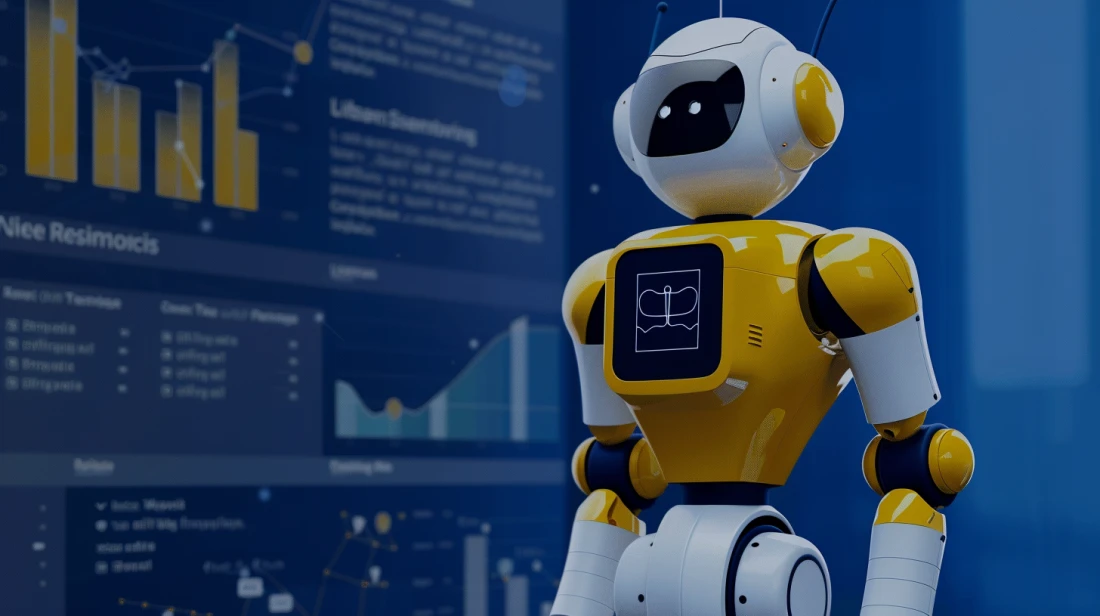How to Choose the Best RPA Tools

Automation is changing the way businesses work. 98% of IT leaders agree that automation is necessary to drive business benefits, but on average, companies are missing out on about 50% of automation opportunities. It’s not because the technology isn’t there, but rather the slow rate of adoption can be attributed to a lack of understanding and resources, as well as the various factors to consider when choosing an RPA tool that is right for your business.
If there was a cost-effective, robust and easy to use tool that would save your business time and money, wouldn’t you want to use it? We will tell you everything you need to know about Robotic Process Automation (RPA), as well as more complex automation tools, and give you best steps as to how to go about choosing the device that is right for your business.
Beyond choosing the right tool, it’s necessary to have the human workforce and experts that can leverage the data in such automation tools to be able to make well-informed business decisions. That’s where more complex automation tools than RPA are useful such as Solvexia can come in handy.
Coming Up
2. What Kind of Tasks Can RPA Help With?
5. Human Analytical Automation
6. How Do I Choose the Best Automation Tools?
7. Features to Consider when Choosing an Automation Tool
What is RPA?
Robotic Process Automation (RPA) uses automation software to mimic a task that would otherwise be completed by a human. For example, RPA software can run applications, process transactions, and manipulate data, to name a few functions.
RPA is ideal for process-oriented tasks as they are designed to follow coded commands and replicate tasks. Unlike humans, RPA can be deployed around the clock and used at scale, in effect, saving your business a lot of time and money, while also increasing the accuracy of work by eliminating the risk of human error. But, RPA tools also have their limitations in the types of functions they can process.
What Kind of Tasks Can RPA Help With?
RPA software solutions offer businesses of all sizes the ability to handle simple, repetitive, low-value tasks that are dependent on accessing companies systems. Its best for getting data from legacy systems, pasting data into reports, or basic if that then this workflow reports.
RPA is the perfect tool to handle mechanical work such as accessing a system and following a procedure. That’s why RPA is so useful for back-office tasks. RPA tools can also send SMS messages, emails, copy data, validate data and more in whatever format its fed and any output you desire. The best part is, there is no coding required!
For example, let’s take a look at the “email confirmation” robot. This robot can be placed into any part of the process to contact approvers, collect feedback and trigger next-step actions. The software can approve expense reimbursements based on sets of rules that your human touch can pre-designate. RPA can track policy exceptions and can unify data from separate systems.
RPA is great for copying and pasting data or collecting data that may have otherwise been a repetitive, manual job that requires minimal thinking but a lot of personal time. It can also be used to prepare cash flow statements by extracting data from bank statements or copying information from scanned invoices.
If a more advanced and high-value analytics and modelling solution are required then human analytical automation might be a better option than RPA, but before looking at this in more detail first, let’s look at the types of RPA tools and options.
Types of Automation Tools
Like people, RPA tools come in different shapes and sizes. It’s important to assess your own business goals before considering the type that will work right for your needs. Here’s a look at some of the different kinds of RPA tools:
Attended automation:
Also known as Robotic Desktop Automation, attended automation is started by the user through the user’s machine. The user launches the RPA code to perform the operations that the employee would otherwise manage, and if need be, the software can ask for help.
Unattended automation:
Running through the cloud, unattended automation completes processes in the background. This is most beneficial for back-office tasks.
Hybrid automation:
For a start to finish automation, attended and unattended automation can be combined into hybrid automation to accomplish both front and back-office work.
-min.jpeg)
Types of RPA Options
In terms of how RPA runs, there are also different options available in the market:
Coded:
The most potent automation tools are programmed with a programming language. While this option is the most sophisticated, it also requires a tech-savvy professional to write the code, and is, therefore, less accessible.
Low-Coded:
As an alternative to a fully coded RPA system, there are low-coded options - graphical user interfaces (GUI) which is a drag and drop visual style to code the system as you wish.
Recorded:
Most vendors offer the option for recording, in which you can record the process for expedited bot programming. However, this option can be risky as there may be a human error in the recording process, and also, if the process happens to change at all, the recording becomes useless.
No Code:
To avoid coding, some RPA software systems are being built with both a robust GUI and recorder.
Self Learning Bots:
When you mix machine learning with RPA, you get intelligent RPA, which is bots that learn from recorded tasks. With enough data, these tools can assess the patterns and begin completing the tasks themselves. The technology is still emerging in the form of intelligent RPA, but it is a promising future.
Human Analytical Automation
In many instances, the simple, low-value data processing of RPA might not be enough, and that’s why more advanced human analytical automation software tools like Solvexia are a better solution. This works by combining the technology of automation with the human element of analytical understanding, thereby augmenting how humans work within departments.
Advanced software such as Solvexia offers high value analytical and modelling tools such as predictive, forecasting and planning among many advanced features. Therefore, employees across all departments can use the tool to manipulate data and produce meaningful results and clarity with the data.
With IT systems unable to keep up with changes in the business and regulatory environment, this tool can analyse the data and align with the business knowledge and expertise of its staff. The system can manipulate and consolidate data from various sources to create a unified reporting system that allows for better decision-making. From daily sales reports to regulatory submissions, the automation tool can help to decrease your compliance risk and enhance operational effectiveness.
The tool can act in accordance to the following workflows: aggregate data, perform calculations, apply predictive modelling, store data for trend analysis, generate visual reports, and incorporate humans by approving and holding commentary.

How Do I Choose the Best Automation Tools?
With all the different options and kinds of automation tools, you’ll want to ensure you’re choosing what is right for your organisation at the current moment, while also considering the plans for your business.
To avoid what 40% of businesses consider to be buyer’s remorse in choosing an RPA tool, you’ll want to start by outlining and defining your objectives, goals and needs. By understanding your needs, you may discover whether you need something more than an RPA tool to equip your teams with to help them accomplish the business goals.
If your needs are simple with a focus on moving data into or between systems such as copying and pasting data, data extraction or connecting systems, then a mechanical solution such as RPA would be the best choice.
If your needs are more advanced with high-value tasks that require staff to combine and analyse data with the deep understanding of business, regulations and customers, then a more advanced human automation tool such as Solvexia would be the ideal choice. The tool can help with data wrangling to validate, transform and cleanse data, provide advanced analytics and reporting, carry out modelling that is predictive, forecasting or planning and much more.
It could also be like many businesses you find that RPA is just the beginning, and both tools are needed to yield the benefits for their teams and departments.
To choose what tool is right for you consider the following:
Vendor-Related Criteria
When it comes to selecting the right vendor, you’ll want to make sure that they offer support and have a vast depth and breadth of experience in the field.
For example, these automation tools can offer design services to avoid the “analysis paralysis” that may be a side effect of having too many choices. In just 1-3 weeks, consultants will help your organisations and respective departments analyse your processes to offer a plan for automation.
Additionally, advanced tools such as Solvexia offers the option to manage your processes for you, and provide training. Rather than relying on RPA company on an ongoing basis to assist with your RPA, you will be set up with everything you require to successfully reap the vast array of benefits that this automation delivers.
Features to Consider when Choosing an Automation Tool
Outside of vendor considerations, you will want to look at the software in terms of the following factors.
At the same time, you’ll want to consider your business goals to decide if an RPA tool will be enough. In many cases, you may prefer a finance-specific automation tool like Solvexia to take the RPA to the next level by incorporating the human element of your finance department.
Ease of Use:
Since various members of your organisation will use the product, you want to make sure it offers a good and simple user experience for all types of users, not just technically savvy employees.
Quick Deployment:
When it comes to initiating a global change within your organisation, time costs money. You want a tool that can be quickly deployed and integrate with your existing tech stack.
Security:
It goes without saying that when dealing with data and essential business analytics, financials and compliance, you need to make sure that the software solution is entirely secure with regular updates.
Maintenance:
Your tool should not add more work to your load. Therefore, a solution that is low maintenance is your best bet.
Scalability:
When deploying this technology, your organisation is bound to grow moving forward. Therefore, as more processes and employees come on board, it’s vital that the tool can scale without losing abilities.
Technicality:
As mentioned above, there are various types of software from coded to recorded solutions.
Cost:
Bringing a robotic process automation software tool into your business is bound to save money as it will automate tedious tasks that humans are currently completing. Therefore, you can shift human resources to the jobs where their intellect and skills can be optimised, but at the same time, you should assess the budget you have available to incorporate an automation tool in your workplace.
It’s always a good idea to request a demo before committing to a software tool!

The Bottom Line
With freed resources, more efficient processes, shorter lead times, simplified workflows, and optimised work, it is no wonder why automation software tools are sought after and necessary to maximise a business’ inputs and outputs.
When considering the options in the market, there’s no need to be overwhelmed as when you can outline your business processes; you can better assess your needs and find the tool that is right for you.
Depending on your needs, you may even decide that an RPA tool for low-value simple tasks will not alone suffice. In these cases, you can consider a more advanced human analytical automation tool like Solvexia to help with more complex business modelling and systematic procurement so that your teams are equipped with the necessary tool to make sound business decisions and accurate forecasts, predictions and planning for the future.
FAQ
Intelligent reconciliation solution
Intelligent rebate management solution
Intelligent financial automation solution
Intelligent Financial Automation Solution
Intelligent financial automation solution
Intelligent financial automation solution
Intelligent financial automation solution
Intelligent financial automation solution
Intelligent regulatory reporting solution
Free up time and reduce errors
Recommended for you

Request a Demo
Book a 30-minute call to see how our intelligent software can give you more insights and control over your data and reporting.

Reconciliation Data Sheet
Download our data sheet to learn how to automate your reconciliations for increased accuracy, speed and control.

Regulatory Reporting Data Sheet
Download our data sheet to learn how you can prepare, validate and submit regulatory returns 10x faster with automation.

Financial Automation Data Sheet
Download our data sheet to learn how you can run your processes up to 100x faster and with 98% fewer errors.

Financial Automation Data Sheet
Download our data sheet to learn how you can run your processes up to 100x faster and with 98% fewer errors.

Financial Automation Data Sheet
Download our data sheet to learn how you can run your processes up to 100x faster and with 98% fewer errors.

Financial Automation Data Sheet
Download our data sheet to learn how you can run your processes up to 100x faster and with 98% fewer errors.

Financial Automation Data Sheet
Download our data sheet to learn how you can run your processes up to 100x faster and with 98% fewer errors.

Financial Automation Data Sheet
Download our data sheet to learn how you can run your processes up to 100x faster and with 98% fewer errors.

Rebate Management Data Sheet
Download our data sheet to learn how you can manage complex vendor and customer rebates and commission reporting at scale.

Top 10 Automation Challenges for CFOs
Learn how you can avoid and overcome the biggest challenges facing CFOs who want to automate.
.svg)







